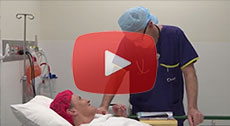Anaesthesia
The Department of Anaesthesia and Perioperative Medicine is one of the largest in Australia, providing a 24 hour service that includes:
- pre-anaesthetic assessment
- anaesthesia inside and outside the operating theatre
- acute postoperative pain management
- labour epidurals.
Our services
We are a major tertiary referral hospital with 22 operating theatres and anaesthesia and perioperative medicine for all surgeries.
Pre-admission and Anaesthetic Clinic
At the Anaesthetic Clinic staff discuss with patients their medical history, pain relief options and answer questions about their anaesthesia. Patients attend this clinic prior to the booked date of surgery.
Acute pain management
Our 24 hour Acute Pain Management Service supervises pain management of postoperative, trauma and medical patients to ensure comfort and to aid recovery while minimising side effects. We use a variety of methods to manage patient’s pain including:
- regional anaesthesia (nerve blocks)
- epidurals
- intravenous patient controlled analgesia
- pain patches
- oral medications.
Regional anaesthesia
Regional anaesthesia (or regional block) can be used safely and painlessly in the place of, or in addition to general anaesthesia. We use regional anaesthesia and ultrasound imaging for nerve blocks, vascular access and transthoracic echocardiography. The benefits of regional anaesthesia include:
- good pain control (including the reduced risk of developing chronic pain after surgery)
- faster recovery
- fewer side effects
- less stress on the body.
Below are some resources about regional anaesthesia.
- Is regional anaesthesia right for you? Regional Anaesthesia fact sheet produced by ANZCA
Our regional block service was awarded the Queensland Health Excellence Award in Innovation in 2015.
Echocardiography (Heart ultrasound)
We have a team of anaesthetists specialising in heart ultrasound (echocardiography) for the management of patients who have severe heart disease requiring urgent surgical procedures. These anaesthetists also provide heart ultrasound for complex vascular procedures. This provides information about heart function while also aiding in the correct positioning of stents in major blood vessels.
Obstetric Anaesthetic Service
The Obstetric Anaesthetic Service provides specialist advice and pain management of expectant mothers throughout their pregnancy and delivery. Women’s anaesthesia provides a full range of services including:
- complex anaesthesia for major gynaecological surgery
- anaesthesia for laparoscopic surgery
- local and regional anaesthesia, including epidurals for labouring women and for caesarean section
- acute pain management.
How to access this service
No external referrals are accepted for this service. You can only access this service when you are staying in hospital or if you have been referred by an RBWH clinician.
Clinics
| Clinic | Phone | Location |
|---|---|---|
| Pre-admission and Anaesthetic Clinic | (07) 3646 6596 | Specialist Outpatient appointments Level 1, Dr James Mayne Building |
Education and training
As part of the University of Queensland’s School of Medicine, we provide students with hands-on operating theatre experience and simulation training through the newly established Centre of Excellence and Innovation in Anaesthesia (CEIA). The CEIA is fitted with specialised equipment that enables us to hold seminars across the country via video link for a wide range of audiences including anaesthetists in rural hospitals.
We are an integral part of the Queensland Anaesthetic Rotational Training Scheme and several members of the department are ANZCA part 1 and part 2 examiners.
Research
Our Research Interest Group for Anaesthesia (RIGA), led by Professor Andre van Zundert, performs research and quality activities in our CEIA to improve anaesthetic practices and evaluate skills and new technologies. For more information email Christine Woods via christinea.woods@health.qld.gov.au or Victoria Eley via v.eley@uq.edu.au.
Contact us
Anaesthesia Medicine Department
Location: Level 4, Ned Hanlon Building
Phone: (07) 3646 7154

